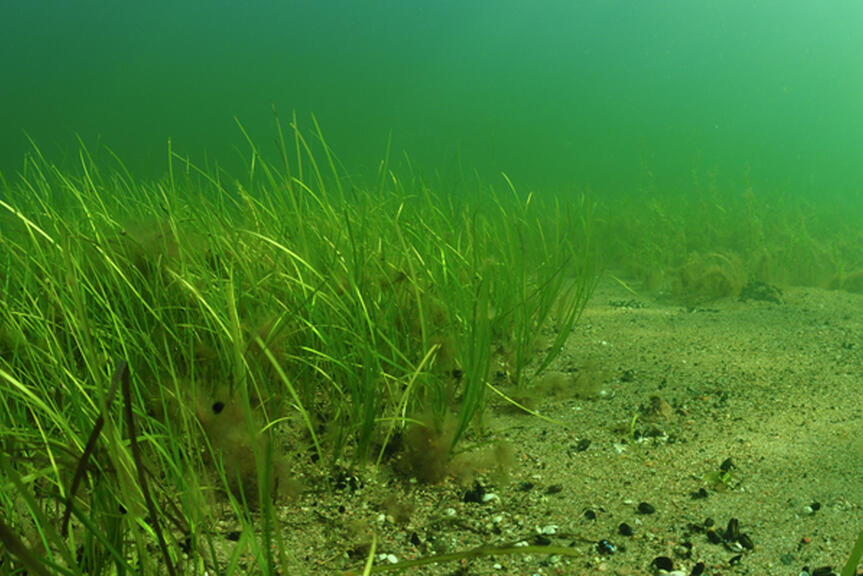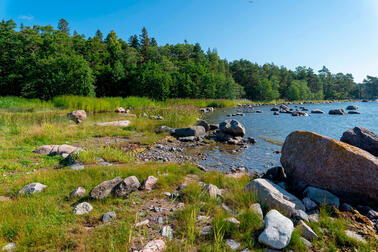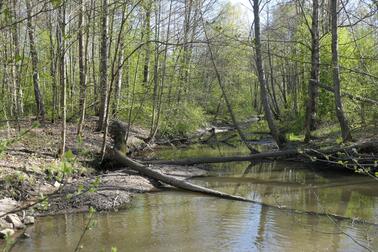
In Finland, this method is being tested for the first time for the restoration of the seabed, as previously no sea-grass had been planted here on the sand added to the bottom. The seabed habitat will be improved by covering the seabed sediment with sand and planting sea-grass (Zostera marina), a bottom-binding and biodiversity-sustaining vegetation, on the sand. Sea-grass is a plant growing on sandy seabeds that is threatened by eutrophication and sedimentation of the seabed. In an optimal environment, the sea-grass forms a meadow that provides shelter and nourishment for many fish and invertebrates. The method has previously been successfully tested in Sweden.
The City of Helsinki's Construction Services municipal enterprise Stara has previously laid sea sand on the seabed. During levelling, the sand blurs the divers' visibility, which is why sea-grass planting will not begin until a few days after the water has cleared.
Sea-grass meadows important for seafloor diversity
Sea-grass meadows are the most diverse habitats in the Baltic Sea, teeming with underwater life. Baby fish, crustaceans, mussels and many other organisms thrive in the meadows. In Finland, other plant species often grow among the meadows. The meadows also effectively bind their growing medium, thereby preventing erosion of the underlying sediments and improving water quality. In addition, extensive sea-grass meadows produce a large amount of oxygen and bind carbon dioxide, thereby acting as carbon sinks.
"Helsinki is committed to preserving the Baltic Sea and biodiversity. This year, we launched a new Baltic Sea programme, which is part of the joint Baltic Sea Challenge between Turku and Helsinki. Restoration of the sea-grass meadow in Hevosenkenkälahti is important for Helsinki. We hope that by restoring the seabed and planting sea-grass, we will be able to increase biodiversity,” says Esa Nikunen, Director-General of the Environment Services of the City of Helsinki.
Sea-grass is classified as a near-threatened species in Finland, and sea-grass meadows are very endangered as a habitat type. Sea-grass is particularly threatened by eutrophication, decreasing water transparency and changes in water temperature and salinity as a result of climate change. Restoration has made it possible to return sea-grass to areas where it has disappeared. Sea-grass beds are a natural habitat type protected by the Nature Conservation Act, and their transplantation is subject to a permit.
Observations from the 1930s in Hevosenkenkälahti
Individual observations of sea-grass have been made in Lauttasaari's Hevosenkenkälahti already in the 1930s, but more reliable observations are from the 1950s. Since then, as a result of human activity, the seabed has become silted and sea-grass has disappeared from the area. Based on the reports of Metsähallitus, the restoration of the seabed and the return of sea-grass to the area can be successful.
“It is great that we are working together with the City of Helsinki and the John Nurminen Foundation to protect the Baltic Sea in such an important way. At the Parks & Wildlife Finland unit of Metsähallitus, we have successfully piloted the restoration of sea-grass meadows in protected areas for a few summers already. It will be very interesting to see how the restoration of the wider habitat works. The sand used in the restoration was saved for this project when the Property Development unit of Metsähallitus carried out research on marine aggregate in connection with the dredging of the Vuosaari harbour fairway. The study investigated the usability of sea sand in the concrete industry and in restoration,” says Aija Nieminen, Land-Use Specialist at the Parks & Wildlife Finland of Metsähallitus.
Restoring marine nature through cooperation
The restoration of Hevosenkenkälahti has brought together experts, volunteers and organisations from different parties. Cooperation has also made it possible to map new sites. We are also aiming to restore new sites already this summer.
The John Nurminen Foundation's Meriniitty project restores sea-grass meadows together with the Parks & Wildlife Finland unit of Metsähallitus. New plantings are carried out primarily outside the state's protected areas in order to restore biodiversity and expand the habitat network to new areas. The project involves volunteer divers mapping potential planting sites. The Helsinki-based H2O diving club also participates in spreading sand in Hevosenkenkälahti. Cooperation with divers is coordinated by the John Nurminen Foundation.
“The help of volunteer divers is very welcome, as there are a lot of places that have been provisionally assessed as suitable, and it takes a lot of time to go through them. The observations collected by the divers make it possible to choose the best sea-grass beds for future plantings,” says Foundation Specialist Miina Mäki.


